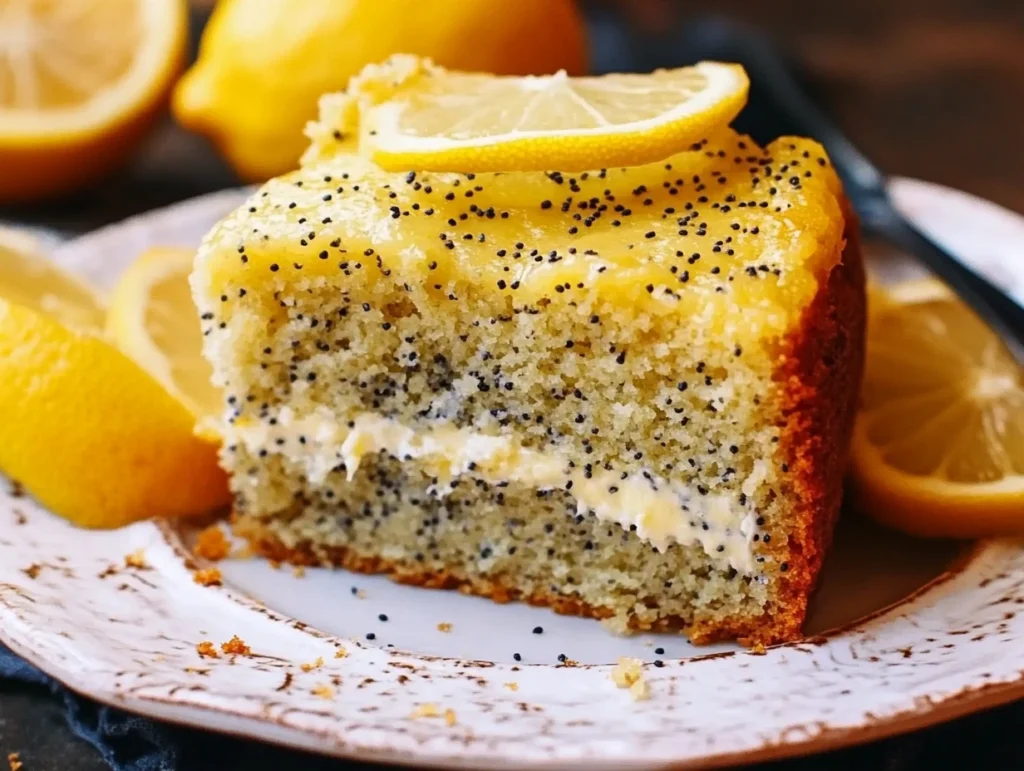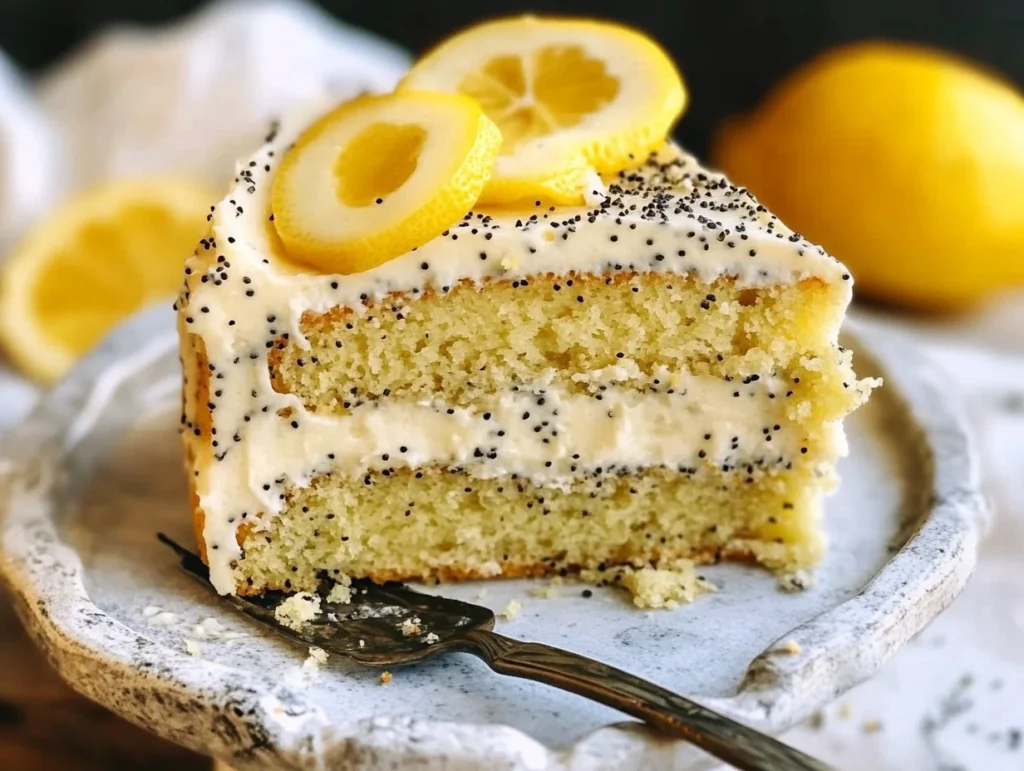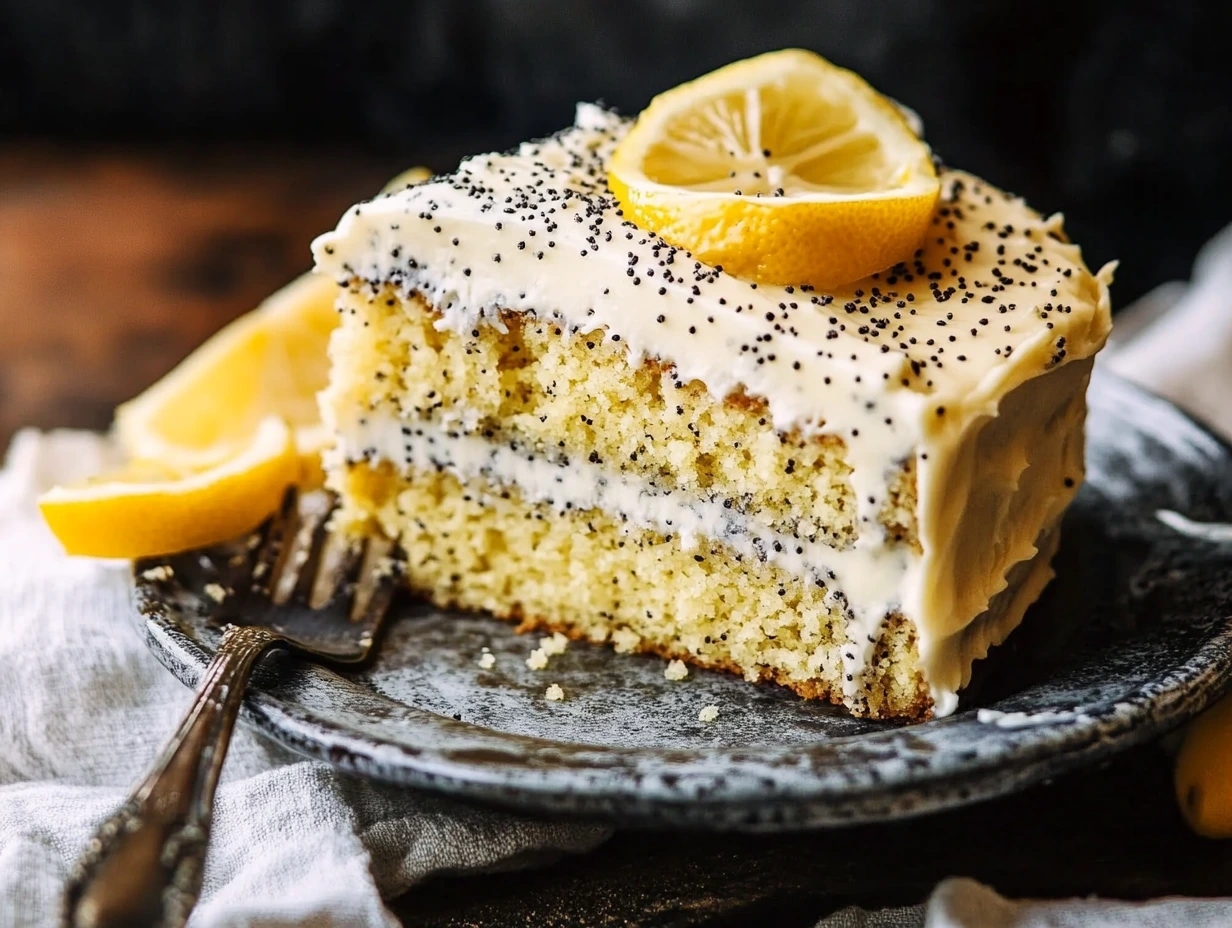Lemon Poppy Seed Cake has stood the test of time as a beloved dessert, cherished for its bright citrus flavor and delicate crunch. The combination of zesty lemon and tiny, nutty poppy seeds creates a balanced taste and texture that appeals to a wide range of palates. Whether served as a breakfast treat, an afternoon snack, or a dessert for special occasions, this cake is always a crowd-pleaser.
One of the reasons for its lasting popularity is its versatility. It can be baked as a loaf, a bundt cake, or even cupcakes, making it suitable for various events. The moist and tender crumb, enhanced by a hint of vanilla or almond extract, ensures that every bite is bursting with flavor. Paired with a simple glaze or a dusting of powdered sugar, Lemon Poppy Seed Cake is both elegant and comforting.
Table of Contents
The Perfect Combination of Citrus and Crunch
What makes this cake truly special is the interplay between tart lemon and the slight crunch of poppy seeds. The lemon provides a refreshing burst of acidity that balances the sweetness of the cake, while poppy seeds contribute a subtle, nutty texture. This contrast elevates the cake from a simple citrus dessert to a multi-dimensional delight.
Lemon zest and freshly squeezed lemon juice are key ingredients that bring out the natural brightness of the fruit. Some variations even include a lemon syrup or glaze to amplify the citrusy goodness. Meanwhile, poppy seeds not only add texture but also complement the lemon with their mild earthiness.
History & Origins
The Evolution of Poppy Seed Cakes
Poppy seeds have been used in baking for centuries, with their origins tracing back to ancient civilizations. The tiny, nutty seeds come from the opium poppy plant, which was cultivated by the Sumerians as early as 3,000 BCE. Poppy seeds quickly became a staple ingredient in European and Middle Eastern baking, prized for their unique texture and mild, nutty flavor.
Throughout history, poppy seed cakes have been particularly popular in Central and Eastern Europe. Countries like Hungary, Poland, and Austria have long-standing traditions of baking rich, sweet cakes and pastries featuring poppy seeds. Traditional desserts such as Makowiec (Polish poppy seed roll) and Mohnkuchen (German poppy seed cake) highlight how deeply embedded poppy seeds are in European culinary heritage.
As baking techniques evolved and flavors merged across cultures, poppy seed cakes found their way into Western-style desserts, eventually pairing with citrus flavors like orange and lemon. This fusion of influences led to the modern-day Lemon Poppy Seed Cake, which perfectly balances the light zestiness of lemon with the subtle crunch of poppy seeds.
Lemon Cakes Through the Ages
Lemons have been used in baking for centuries, dating back to ancient Rome. The Romans were among the first to cultivate lemons and incorporate them into their cooking, particularly in sweet and savory dishes. However, it wasn’t until the Middle Ages that lemon-flavored desserts became more common, thanks to the expansion of trade routes that brought citrus fruits to Europe.
During the Renaissance, lemon cakes became popular among the European elite, particularly in France and England. Early recipes often featured lemon zest and juice combined with butter, sugar, and flour to create delicate, citrus-infused treats. The Victorian era saw the rise of lemon sponge cakes and tea cakes, which were enjoyed as part of elegant afternoon teas.
In the 20th century, lemon cakes became a household favorite, with recipes appearing in cookbooks worldwide. With the advent of modern baking techniques, bakers began experimenting with various additions, leading to the incorporation of poppy seeds. Today, Lemon Poppy Seed Cake is a timeless classic, celebrated for its refreshing flavor, tender crumb, and satisfying crunch.

Essential Ingredients
Key Components of a Perfect Cake
A truly delicious Lemon Poppy Seed Cake depends on the right balance of ingredients. Here are the key components that contribute to its moist texture and bright flavor:
- Flour – Provides structure and stability to the cake. All-purpose flour or cake flour is commonly used.
- Sugar – Sweetens the cake and enhances the citrus flavor. Granulated sugar is the most common choice.
- Eggs – Add richness, help bind the ingredients, and contribute to a light, airy texture.
- Butter or Oil – Keeps the cake moist and tender. Butter adds richness, while oil ensures a softer crumb.
- Baking Powder & Baking Soda – These leavening agents help the cake rise and achieve a fluffy texture.
- Milk, Buttermilk, or Yogurt – Enhances moisture and gives the cake a tender bite. Buttermilk or yogurt adds a slight tang that complements the lemon.
- Vanilla or Almond Extract – Adds depth to the flavor profile. Almond extract pairs particularly well with poppy seeds.
The Role of Poppy Seeds in Baking
Poppy seeds may be small, but they play a significant role in baking. These tiny black or blue seeds:
- Add a subtle nutty flavor that enhances the overall taste of the cake.
- Provide a delicate crunch that contrasts with the softness of the cake.
- Are rich in healthy fats and minerals, making them a nutritious addition to baked goods.
To get the best flavor from poppy seeds, some bakers prefer to soak them in milk or warm water before incorporating them into the batter. This helps soften the seeds slightly and release their natural aroma.
Choosing the Best Lemons
Since lemons are the star ingredient in this cake, selecting high-quality, fresh lemons is crucial. Here’s what to look for:
- Firm, heavy lemons – A heavier lemon usually has more juice.
- Bright yellow color – Avoid lemons with green spots, as they may be underripe.
- Thin, smooth skin – These tend to have more juice and less bitter pith.
For the best flavor, use both fresh lemon juice and zest in your cake. The zest contains essential oils that enhance the lemony aroma, while the juice provides a tangy, refreshing kick.
Equipment & Tools
Must-Have Baking Tools
To bake a perfect Lemon Poppy Seed Cake, having the right equipment is just as important as using quality ingredients. Here are the essential tools you’ll need:
- Mixing Bowls – A set of various sizes for combining dry and wet ingredients separately.
- Electric Mixer or Whisk – A hand or stand mixer makes creaming butter and sugar easier, but a sturdy whisk works in a pinch.
- Measuring Cups & Spoons – Accurate measurements ensure the perfect balance of ingredients.
- Citrus Zester & Juicer – A fine zester helps extract flavorful lemon zest, while a juicer makes squeezing fresh lemon juice effortless.
- Sifter – Helps aerate flour and remove any lumps for a lighter cake texture.
- Spatula & Wooden Spoon – Ideal for folding ingredients together without overmixing.
- Cake Pan or Loaf Pan – Choose a bundt pan, loaf pan, or round cake pan, depending on your preference.
- Parchment Paper or Non-Stick Spray – Prevents sticking and makes cleanup easier.
- Cooling Rack – Allows air circulation for even cooling and prevents the cake from becoming soggy.
Alternative Baking Methods
If you don’t have a traditional oven or want to experiment, there are alternative ways to bake your cake:
- Air Fryer – Bake small portions or cupcakes in an air fryer at 325°F (163°C) for about 15–20 minutes.
- Slow Cooker – Pour the batter into a greased slow cooker and cook on low for 2–3 hours until set.
- Microwave Mug Cake – For a quick single-serving option, microwave a small portion of batter in a mug for 1–2 minutes.
Step-by-Step Recipe
Ingredients List
For the Cake:
- 2 cups (250g) all-purpose flour
- 1 ½ teaspoons baking powder
- ½ teaspoon baking soda
- ½ teaspoon salt
- 3 tablespoons poppy seeds
- 1 cup (200g) granulated sugar
- ½ cup (115g) unsalted butter, softened
- 2 large eggs
- 1 tablespoon lemon zest
- ¼ cup (60ml) fresh lemon juice
- 1 teaspoon vanilla extract (or almond extract for a nutty twist)
- ¾ cup (180ml) buttermilk or plain yogurt
For the Lemon Glaze (Optional):
- 1 cup (120g) powdered sugar
- 2–3 tablespoons fresh lemon juice
Baking Instructions
- Preheat the Oven
- Set your oven to 350°F (175°C). Grease and flour your chosen cake pan or line it with parchment paper.
- Prepare the Dry Ingredients
- In a medium bowl, whisk together the flour, baking powder, baking soda, salt, and poppy seeds.
- Mix the Wet Ingredients
- In a large bowl, beat the butter and sugar together until light and fluffy.
- Add the eggs one at a time, mixing well after each addition.
- Stir in the lemon zest, lemon juice, and vanilla extract.
- Combine Wet & Dry Ingredients
- Gradually add the dry ingredients to the wet ingredients, alternating with buttermilk (or yogurt). Mix until just combined—do not overmix.
- Bake the Cake
- Pour the batter into the prepared cake pan. Smooth the top with a spatula.
- Bake for 40–45 minutes (loaf pan) or 50–55 minutes (bundt pan), or until a toothpick inserted into the center comes out clean.
- Cool & Glaze
- Let the cake cool in the pan for 10 minutes, then transfer it to a wire rack.
- If using the glaze, whisk together powdered sugar and lemon juice, then drizzle over the cooled cake.
Common Mistakes & Fixes
- Dry Cake? – Overbaking or too much flour. Check for doneness a few minutes early and use the spoon-and-level method to measure flour.
- Cake Didn’t Rise? – Expired baking powder/soda or overmixing. Use fresh leavening agents and mix until just combined.
- Soggy Middle? – Underbaking. Insert a toothpick in the center to ensure it’s fully baked.
- Lemon Flavor Too Weak? – Increase lemon zest and juice for a stronger citrus kick.

Variations & Substitutes
Gluten-Free & Vegan Options
Gluten-Free Version:
- Replace all-purpose flour with a gluten-free 1:1 baking blend.
- Add an extra egg or 1 tablespoon of cornstarch to improve structure.
Vegan Version:
- Use dairy-free butter and plant-based yogurt (coconut or almond).
- Replace eggs with flax eggs (1 tablespoon flaxseed meal + 3 tablespoons water per egg).
- Substitute maple syrup for honey-based glazes.
Healthier Ingredient Swaps
- Whole Wheat Flour – Replace up to half of the flour for added fiber.
- Greek Yogurt – Swap for butter to reduce fat while keeping the cake moist.
- Honey or Maple Syrup – Use instead of refined sugar for a natural sweetener.
- Coconut Oil – A healthier fat alternative to butter, adding a slight tropical flavor.
Tips for the Perfect Cake
Baking Secrets from Professionals
Want to bake a bakery-quality Lemon Poppy Seed Cake at home? Here are some expert tips:
- Use Room Temperature Ingredients – Butter, eggs, and buttermilk should be at room temperature for better mixing and a uniform texture.
- Measure Accurately – Use a kitchen scale or the spoon-and-level method for flour to avoid dense cake.
- Cream Butter & Sugar Well – Whip them together for 2–3 minutes until light and fluffy to create an airy cake.
- Don’t Overmix the Batter – Overmixing activates the gluten, making the cake tough. Stir until ingredients are just combined.
- Bake in the Center of the Oven – Even heat distribution ensures a perfectly risen cake with a golden crust.
- Use Fresh Baking Powder & Baking Soda – Old leavening agents won’t provide the necessary lift, leading to a dense cake.
How to Achieve a Moist Texture
- Add a Little Oil – Replacing part of the butter with vegetable oil or coconut oil enhances moisture.
- Use Buttermilk or Yogurt – These ingredients create a tender crumb and add a slight tang that balances the sweetness.
- Brush with Lemon Syrup – After baking, lightly brush the cake with a lemon simple syrup for extra moisture and flavor.
- Don’t Overbake – Check for doneness 5 minutes early and use a toothpick test. Overbaking dries out the cake.
Frosting & Toppings
Best Frosting Options
Lemon Poppy Seed Cake pairs beautifully with various frostings. Here are some delicious options:
- Lemon Glaze – A simple mix of powdered sugar and lemon juice for a light, tangy finish.
- Cream Cheese Frosting – A rich, slightly tangy frosting that complements the citrus flavor.
- Whipped Mascarpone Frosting – Light, creamy, and slightly sweet, perfect for a sophisticated touch.
- Honey-Lemon Buttercream – A silky buttercream infused with honey and fresh lemon zest.
- Greek Yogurt Frosting – A healthier alternative with a creamy, slightly tart taste.
Creative Garnishing Ideas
- Lemon Zest & Poppy Seeds – A simple but elegant topping.
- Fresh Berries – Blueberries, raspberries, or blackberries add color and a fruity burst.
- Candied Lemon Slices – Adds a decorative and sweet-tart touch.
- Toasted Almonds – Enhances crunch and nuttiness.
- Edible Flowers – Lavender or chamomile flowers create a bakery-style presentation.
Pairing Suggestions
Ideal Beverage Pairings
Pair your Lemon Poppy Seed Cake with the perfect drink:
- Tea – Earl Grey, chamomile, or lemon-infused green tea complement the citrus notes.
- Coffee – A smooth latte or cappuccino balances the cake’s sweetness.
- Sparkling Lemonade – A refreshing, zesty drink that enhances the cake’s flavors.
- Dessert Wine – A sweet Riesling or Moscato pairs beautifully with citrus-based desserts.
Perfect Occasions for Serving
Lemon Poppy Seed Cake is versatile and suits many events:
- Brunch Gatherings – A light, flavorful addition to any breakfast or brunch menu.
- Afternoon Tea – Perfect for a sophisticated tea party.
- Spring & Summer Celebrations – Refreshing and bright for warm-weather events.
- Holidays & Special Occasions – Works well for Easter, Mother’s Day, or birthdays.
- Gift Giving – Wrap a loaf in parchment paper and ribbon for a homemade gift.
Storage & Shelf Life
How to Store for Maximum Freshness
To keep your cake fresh and delicious:
- At Room Temperature – Store in an airtight container for 2–3 days.
- In the Refrigerator – Keeps for up to a week in an airtight container. Bring to room temperature before serving.
- Avoid Storing in Direct Sunlight – Heat can dry out the cake and affect the glaze.
Can You Freeze Lemon Poppy Seed Cake?
Yes! Freezing is a great way to preserve your cake:
- Freeze the Whole Cake – Wrap it tightly in plastic wrap, then foil, and store for up to 3 months.
- Freeze Individual Slices – Wrap slices separately and place them in a freezer-safe bag for easy thawing.
- Thawing Instructions – Let the cake thaw overnight in the fridge or for a few hours at room temperature.

Nutritional Information
Caloric Breakdown
A standard slice (1/10 of a loaf or bundt cake) contains approximately:
- Calories: ~250–300
- Carbohydrates: ~35g
- Sugars: ~18g
- Protein: ~4g
- Fat: ~12g
- Fiber: ~2g
(Values vary based on ingredients and portion size.)
Health Benefits of Poppy Seeds
Poppy seeds aren’t just for texture—they offer health benefits too!
- Rich in Antioxidants – Helps combat inflammation.
- Good Source of Fiber – Aids digestion.
- Contains Healthy Fats – Beneficial for heart health.
- High in Calcium & Magnesium – Supports bone strength.
Common FAQs
Why Did My Cake Turn Out Dry?
A dry cake is often caused by one of the following:
- Overbaking – Even a few extra minutes in the oven can dry out the cake. Check for doneness a few minutes before the recommended baking time by inserting a toothpick—if it comes out with a few moist crumbs, the cake is done.
- Too Much Flour – Measuring flour incorrectly (such as scooping directly from the bag) can lead to using too much. Instead, use the spoon-and-level method or a kitchen scale.
- Not Enough Moisture – Ingredients like butter, oil, buttermilk, or yogurt help keep the cake soft. If you reduced fat or liquid ingredients, this might be the cause.
- Lack of Sugar – Sugar not only sweetens but also retains moisture. Reducing sugar too much can lead to a drier texture.
Can I Use Bottled Lemon Juice?
Technically, yes, but fresh lemon juice is always better. Fresh juice has a brighter, more natural citrus flavor, while bottled lemon juice often contains preservatives that can give it a slightly bitter or artificial taste.
Best alternative: If you don’t have fresh lemons, try using lemon extract (½ teaspoon per tablespoon of lemon juice) or a mix of white vinegar and lemon zest for acidity and aroma.
How Long Should I Soak Poppy Seeds?
Soaking poppy seeds before baking is optional, but it can enhance their texture and flavor.
- Quick Soak: 15–20 minutes in warm milk, water, or buttermilk.
- Overnight Soak: For a softer texture, soak in milk or yogurt overnight in the fridge.
Soaking helps soften the seeds, making them more digestible and preventing them from feeling gritty in the cake. If your recipe already includes a liquid ingredient like buttermilk, you can stir the poppy seeds in and let them sit while you prep the other ingredients.
Best Flour Alternatives?
If you want to swap out all-purpose flour, here are some great alternatives:
- Gluten-Free Flour Blend – A 1:1 baking mix works best for a gluten-free version.
- Almond Flour – Adds a nutty flavor but will make the cake more delicate. Combine with a binding agent like xanthan gum.
- Whole Wheat Flour – Use half whole wheat and half all-purpose for a slightly denser but healthier cake.
- Oat Flour – Makes for a more tender, slightly crumbly cake. Use 1¼ cups oat flour for every 1 cup of all-purpose flour.
Can I Make It Without Eggs?
Yes! If you need an egg substitute, try these options:
- Flax Egg: 1 tablespoon flaxseed meal + 3 tablespoons water (let sit for 5 minutes).
- Unsweetened Applesauce: ¼ cup per egg. Adds moisture but may make the cake slightly denser.
- Mashed Banana: ½ a banana per egg. Works best for a sweeter, slightly denser cake.
- Yogurt or Buttermilk: ¼ cup per egg for a moist texture.
How Do I Prevent a Dense Cake?
A dense Lemon Poppy Seed Cake can result from:
- Overmixing the batter – Overmixing activates gluten, making the cake tough. Stir only until ingredients are just combined.
- Too little leavening – Ensure your baking powder and baking soda are fresh (replace every 6 months).
- Not enough air in the batter – Cream butter and sugar properly for at least 2–3 minutes to incorporate air.
- Heavy ingredient swaps – Whole wheat flour, almond flour, or using too many liquid sweeteners (like honey or maple syrup) can create a denser texture.
To enhance the internal linking structure of the Lemon Poppy Seed Cake article, consider adding relevant links to other recipes on Starry Recipes that complement the flavors, ingredients, or baking techniques discussed. For example, if readers are interested in other lemon-based baked goods, linking to the Lemon Cupcakes – A Zesty Delight can provide them with another citrus-infused treat to try. Additionally, for those looking for a healthier alternative or different variations, referencing the Banana Bread Recipe Using Oil can introduce them to an oil-based baking method that keeps cakes moist. Lastly, if readers enjoy fruit-infused flavors, the Lemon Blueberry Granola Clusters offer a crunchy and nutritious snack that pairs beautifully with tea, just like the Lemon Poppy Seed Cake.
Conclusion
Lemon Poppy Seed Cake is a timeless classic that perfectly balances zesty citrus flavors with a delicate crunch. Whether you’re baking it for a special occasion, a cozy afternoon treat, or simply to satisfy a sweet craving, this cake delivers moisture, texture, and bright flavor in every bite. By selecting the best ingredients, using the right techniques, and experimenting with variations like gluten-free or vegan options, you can customize this dessert to suit any preference.

